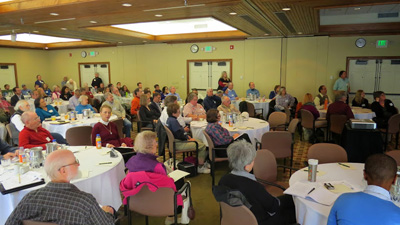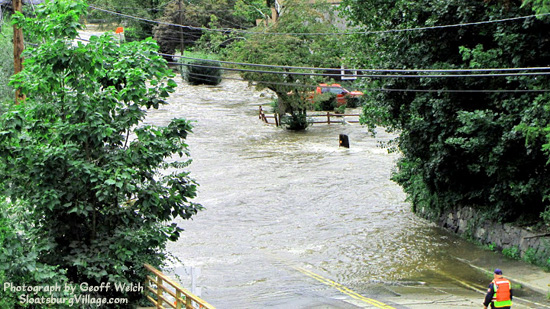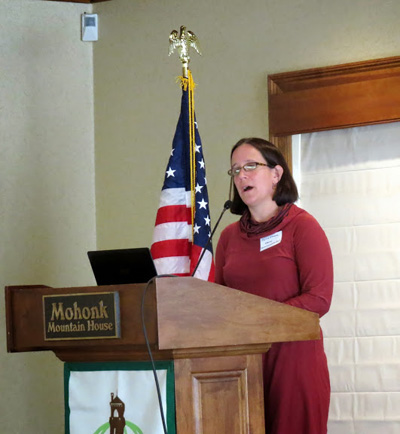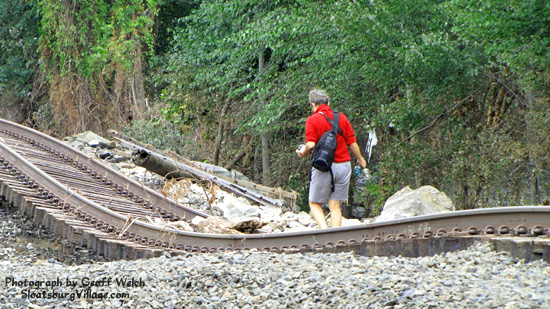By Geoff Welch, Ramapo River Watershed Keeper
Last week, I attended The Hudson River Watershed Alliance’s annual conference, titled “A Watershed Moment: Changing Climate & the Future of Our Water Resources held, at the scenic Mohonk Mountain House outside New Paltz, New York on the Shawangunk Ridge. The program was co-sponsored by Mohonk Consultations.
The focus was expressed as “climate trends and the experiences of the last years indicate that our Hudson Valley Region communities are likely to expect different weather patterns in coming decades. Understanding the impact of these trends on our water resources and charting ways to help our region to be more resilient . . . the increased incidence of flooding and the need for more careful water management are complex challenges already being faced by many local towns and villages.”
This is certainly the case here in the Village of Sloatsburg in the valley of the Ramapo River which has weathered several storms in recent years –the worst being Tropical Storm Irene (August, 2011) during which the heaviest rainfall in the Ramapo watershed occurred in Tuxedo and Sloatsburg, where almost a foot of rain fell. Two bridges along Seven Lakes Drive were destroyed. The Metro North track and track bed were heavily damaged. Repairs took months and cost Metro North 40 million dollars.
150,000 tons of stone had to be moved back to the track bed or replaced with new stone. Twisted rail had to be replaced. (I don’t have a figure yet for the new bridges and road repairs.)
Julie Moore, Water Resources Group Leader, Stone Environmental, Montpelier, VT, spoke on, Land Use and Stream Management Strategies for Reducing Flood Risks and Protecting Water Quality.
Although recent reports project a one meter sea level rise by the end of this century. Scientists are already correcting that figure to two meters – about 6 feet!
 However the rise doesn’t stop there but will continue beyond the end of this century since we seem to be on a frenzied fossil fuel burning binge and the world’s population and consumption of natural resources continues to grow. This evolving sea level rise will have major impact of the Hudson River which is an “arm of the sea” – an estuary.
However the rise doesn’t stop there but will continue beyond the end of this century since we seem to be on a frenzied fossil fuel burning binge and the world’s population and consumption of natural resources continues to grow. This evolving sea level rise will have major impact of the Hudson River which is an “arm of the sea” – an estuary.
More heating of the oceans also increases the energy and water vapor available for storm development so we can expect more severe storms than will continue to stress both coastal and inland areas such as The Ramapo River Watershed. With its highlands topology and railroads and highways crowding in on the Ramapo River, our watershed is very vulnerable. We need to limit development, protect open space, enhance natural wetland areas and forested stream corridors and engineer more resilience into our stormwater systems.
The Ramapo/Mahwah Sole Source Aquifer is a major water supply resource for Rockland and Bergen Counties and is vulnerable to pollution such as the fuel spills from SOS Fuel that stormwater spread throughout the downstream Ramapo River corridor during Tropical storm Irene. Another great reason to switch from fossil fuel is getting rid of potential pollution sources such as storage tanks of gas and fuel oil in watersheds.
Meanwhile the overarching, or perhaps I should say burning question is – can the people of planet earth kick their fossil fuel addiction?
Photography by Geoff Welch.






